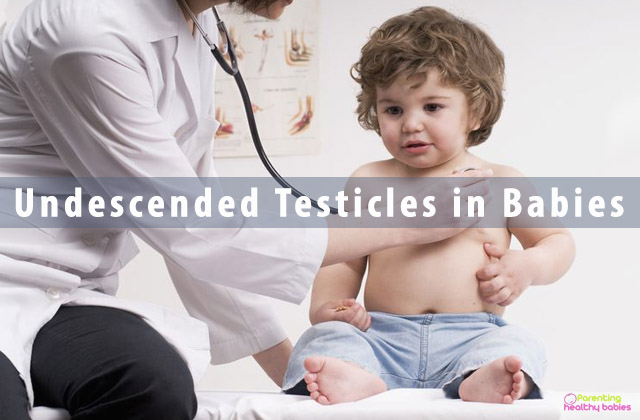Undescended testicles are common in premature babies. Some of the factors that might increase the risk of the undescended testicle in a newborn includes low birth weight less than 2500 gm, premature birth before 37 weeks of gestation and the earlier the birth, alcohol use by the mother during pregnancy, Cigarette smoking and tobacco consumption by the mother, etc. to name a few.
The testes are 2 egg-shaped male reproductive organs located in the scrotum. They produce sperm and the male hormone called testosterone. The scrotum keeps the testicles in a cooler setting than the body. This is because sperm can not grow at body temperature, so scrotum maintains the temperature. During childhood, sperm in the testicles goes through a process that results in mature sperm at puberty. Normally the testicles are formed early in a boy’s growth. They form in the lower belly region that is in the abdomen but descend into the scrotum toward the end of pregnancy.
What are Undescended Testicles?
Sometimes, a boy’s testicles descend by the time he is 9 months old. Undescended testicles are common in infants who are born early. Undescended testicles occur when one or both the testicles fail to drop or move into the normal place in the scrotum before birth. It is also called as cryptorchidism. Testicles that do not naturally descend into the scrotum are considered as abnormal. By bringing the testicle into the scrotum it can improve sperm production and also increase the chances of good fertility.
What are Retractile Testes?
Some babies can also have a condition in which testicles are not found that is called as retractile testes which is different from undescended testicles. Although the testicle is normal, it is pulled back out of the scrotum by a muscle reflex. This occurs because the testicles are still small before puberty. Therefore, the testicles will descend normally at puberty. In other cases, no testicle may be found, even during surgery. This may be due to the problem that occurred while the baby was still developing before birth.
Symptoms for Undescended Testicles
The most common symptom for this is a nonpalpable or unpalpable testis. This is not felt during a physical examination. There are three types of nonpalpable testis-
- Abdominal
- Inguinal
- Atrophic or absent
According to a study this condition is found in an about 3 or 4 out of 100 newborns (and upto 21 out of 100 premature newborns). During the first 3 months of life, about half of the testicles will drop on their own. But testicles won’t drop on their own after 3 months of age. Thus, about 1 or 2 out of 100 boys with undescended testicles will need treatment.
Causes for Undescended Testicles
Proper cause for the failure to drop of testicles is not known. It may be because the testicles are not normal to start with or the testicles drop but miss the scrotum and ending up next to the scrotum instead. This condition is called ectopic testides. Also it maybe that the baby’s hormones can’t stimulate the testicles normally.
Babies born with klinefelter syndrome, spina bifids and down syndrome are more likely to have undescended testes. However, for many babies the cause is unknown.
According to the pediatric urologists research it is found that-
- Up to to one-third of premature male infants have an undescended testis
- Undescended testes occur in approximately 3 to 5 percent of male infants
- 14 percent of males with undescended testes also had a male relative with the condition
- Boys who have undergone an inguinal hernia repair may develop undescended testes
Factors that might increase the risk of the undescended testicle in a newborn include-
- Low birth weight less than 2500 gm
- Premature birth before 37 weeks of gestation and the earlier the birth
- Alcohol use by the mother during pregnancy
- Cigarette smoking and tobacco consumption by the mother
- Maternal exposure to estrogen during the first trimester
- Multiple births
- Small size for gestational age
- Down syndrome
- Conditions that can slow fetal growth
- Exposure to pesticides or hormone-disrupting chemicals
- Family history of problems of genital development
Complications With Undescended Testicles
- Testicular cancer in one or both testes
- Infertility occur later in life
- Damage to the testicle from surgery
- Testicular torsion
- Development of a hernia near the groin region
- Psychological consequences of an empty scrotum
- Damage to the vas deferens
Diagnosis
To diagnose an undescended testicle, the bay is usually placed in a warm bath. If the testicle is not in the scrotum and cannot be felt than following can be done-
- Ultrasound scan
- MRI scan
- Laparoscopy
Treatment for Undescended Testicles
In most of the cases, the testicle will descend without the treatment during child’s first year. But if this does not occur, treatment may include moving the undescended testicle to its proper location in the scrotum-
- Hormone injections like B-HCG or testosterone which bring the testicle into the scrotum.
- Surgery to bring the testicle into the scrotum. The treatment is called orchiopexy. It is performed between 6 and 18 months and is successful in 98 % of children. It should definitively be performed before a child is two years old as delaying the operation may increase the long-term risk of developing testicular cancer or infertility. The surgeon makes a small incision in the abdomen and uses small surgical instruments to move the testicle down the inguinal canal and place it in the scrotum. After this, the inguinal canal is sealed to stop the testicle from going back up.
Recovery After Surgery
After surgery, the child will have pain, swelling and bruises in his groin region.
- Let the child rest and sleep
- Do not let the child do exercise
- Make the child drink plenty of fluids
- Medicines to relieve pain
- Avoid bathing for at least the first 2 days
- Groin may be tender, make sure the child wears loose fitting clothes
- Child should not ride a bicycle or use sit-on toys for a few weeks after the operation
Testes are male reproductive organ if they do not drop into scrotum it leads to undescended testicles. The standard and most common treatment for this is surgery called as orchiopexy which helps to find the testicles, then bring it down into the scrotum. Certain things should be taken care of for the child after the operation.













